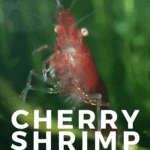Cherry shrimp (Neocaridina davidi) are colorful, easy-to-keep invertebrates that look great in the tropical aquarium, with or without fish. Read this guide to learn about their care, feeding, and tank mates.
These beautiful little shrimp add color and interest to your tank, as well as help to keep things clean and tidy by grazing on algae on tank surfaces, detritus, and leftover fish food.
But what tank mates work well with Cherry shrimp? What’s the average lifespan of Neocaridina davidi?
Read this guide to learn how to care for Cherry red shrimp, find out more about breeding them, and check out our Neocaridina shrimp color chart!
Cherry Shrimp – Species Profile
Scientific Name
Neocaridina davidi
Common Name (species)
Cherry shrimp, Neocaridina shrimp, Red Cherry shrimp
Family
Atyidae
Origin
Taiwan
Diet
Omnivorous scavengers
Care Level
Easy
Activity
Active
Lifespan
1 to 2 years
Temperament
Peaceful
Tank Level
Mostly bottom-dwellers
Minimum Tank Size
5 gallons
Temperature Range
65o to 85o F
Water Hardness
6 to 8 dGH
pH Range
6.5 to 8.0
Filtration/Flow Rate
Well-filtered, gentle flow
Water type
Freshwater
Breeding
Egg-layers. Easy to breed in captivity
Compatibility
Snails, shrimp, small peaceful fish
OK, for Planted Tanks?
Do best in a heavily-planted tank
Cherry Shrimp Origins and Habitat
Neocaridina davidi is a dwarf shrimp that comes from Taiwan, where they’re found in freshwater ponds and streams. You can also find introduced Cherry shrimp living in parts of Asia, Europe, and Oahu in Hawaii.
The shrimp prefer heavily-vegetated areas with well-oxygenated water, a gentle current, and a rocky substrate.
Appearance
The Cherry shrimp that you’ll find for sale in your local fish store is brightly colored and graded according to their color.
Grading dictates the shrimp’s price, with the deepest crimson-colored specimens fetching a higher price than paler ones.
Cherry Shrimp Grading Color Chart
Fish bowls and tanks
2.5 and under
(not recommended for bettas)
Raising Water ~10°F
5 to 7.5 Watts
May not be reliable
Raising Water More Than 10°F
7.5 to 10 Watts
May not be reliable
Aquarium Size (gallons) 5
Raising Water ~10°F
15 to 25 Watts
Raising Water More Than 10°F
50 Watts
Aquarium Size (gallons)10
Raising Water ~10°F
50 Watts
Raising Water More Than 10°F
100 Watts
Aquarium Size (gallons) 20 to 25
Raising Water ~10°F
100 to 150 Watts
Raising Water More Than 10°F
150-200 Watts
Neocaridina davidi comes in a wide range of vibrant colors that can really make your tank pop.
Favorite colors with hobbyists include Sakura red Cherry shrimp and blue velvet, although you can get violet, yellow, black, green, and orange.
How Big Do Cherry Shrimp Grow?
Female shrimp are around 1.5 inches in length, with males being a little smaller.
Activity Level and Behavior
Cherry shrimp are peaceful little creatures that won’t hassle your fish or other inverts.
These brightly colored little guys spend their days foraging around on the substrate for scraps of food or picking your decorations and aquarium plants clean. The shrimp can be active during the day and at night, giving you plenty of chances to see them in action!
Molting
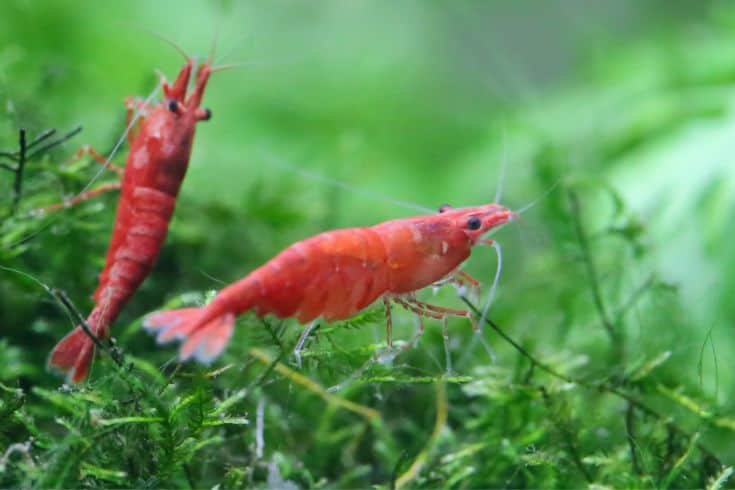
Like all crustaceans, Cherry shrimp have a hard exoskeleton that protects their vulnerable soft insides.
Shrimp molt or shed their old exoskeleton once a month to allow for growth. Once it has molted, the shrimp is vulnerable to attack by predators, so it hides away until the new carapace hardens.
If you spot an old shrimp shell in your tank, don’t remove it, as the shrimp ingest the shell to utilize the calcium it contains.
Tank Mates
Cherry shrimp are peaceful creatures that make safe companions for many other species, including a lonely betta fish. The following species make suitable companions for Cherry shrimp:
- Freshwater snails
- Freshwater shrimp
- Small catfish
- Tetras
- Otocinclus catfish
Basically, any species of small, non-aggressive fish can make suitable tank mates for Cherry red shrimp.
However, you must never put large, predatory fish with Cherry shrimp in case the shrimp become a source of food for the fish!
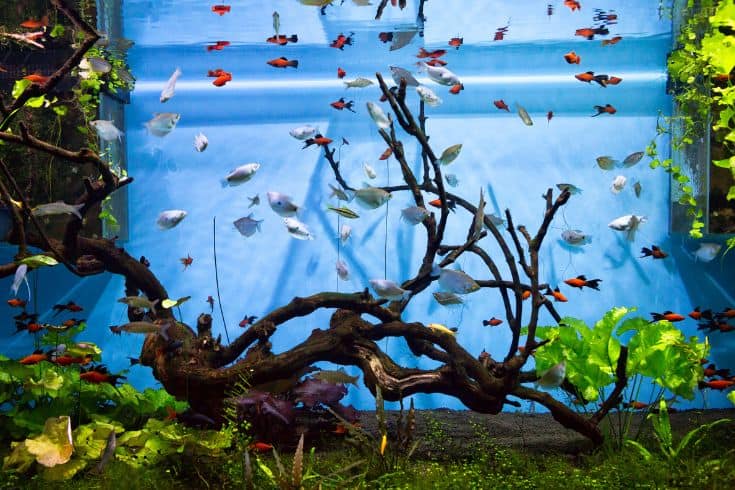
We recommend keeping expensive, high-grade shrimp in a single-species tank.
Can Cherry Shrimp Live Together?
When I had Cherry red shrimp in my tank, I kept them in a large group of around 12. That worked well, as it prevented squabbling if one shrimp was more dominant than the others.
It’s not recommended that you keep these shrimps singly or in pairs, and you can have up to five shrimps per gallon of water without overstocking. Ideally, you want to keep more males to females if you’re hoping to breed from your shrimp.
Diet and Feeding
In the wild environment, Cherry shrimp are scavengers that will eat pretty much whatever they find, including algae, plant matter, and meaty foods.
In captivity, you should feed your shrimp invert pellets, algae wafers, and frozen meaty foods. Cherry shrimp also appreciate the inclusion of veggies in their diet, such as zucchini, cucumber, spinach, carrot, and lettuce, which encourages more vivid color intensity in the shrimp.
The shrimp will graze on most species of algae, helping to keep your viewing panes clear.
Tank Requirements
Tank size
Thanks to their tiny size, Cherry shrimp are the perfect candidates for life in a nano tank as small as 5 gallons.
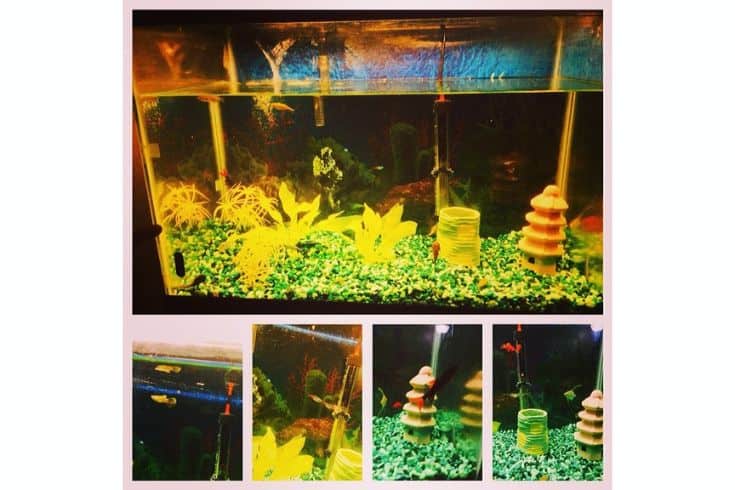
Tank Setup
Substrate
Coarse gravel and smooth pebble replicate conditions in the Cherry shrimp’s natural environment and look good, too. In addition, gravel provides a platform for the growth of biofilm and a film of algae.
Decoration
Cherry shrimp need a densely planted tank with ample hiding places that can be provided by using twisted roots and pieces of driftwood. That provides excellent cover for full-grown shrimp and juveniles.
Lighting requirements
Shrimp don’t need any specific lighting requirements. However, if you have live aquarium plants, you’ll need to give them between eight and ten hours of light per day.
Water Quality
Filtration
Shrimp need well-filtered, clean water in their tank. However, I always find that a sponge pre-filter works best for shrimp, as that prevents them from being sucked into the filter.
Water Parameters
Water Temperature
Cherry shrimp are pretty hardy animals that can tolerate a range of water temperatures from 65 to 85 degrees F, so you might not need to heat your tank if you live in a warm climate.
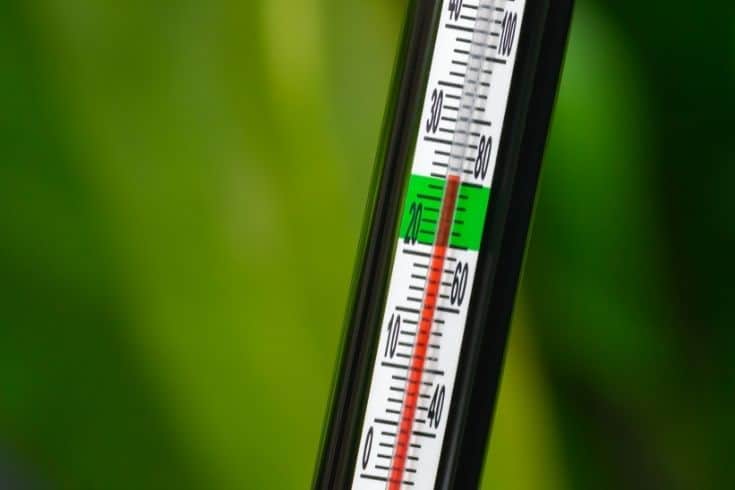
Water Hardness and pH Range
The ideal pH level for Cherry shrimp is between 6.5 and 8.0, with a water hardness of 6 to 8 dGH.
Aquarium Maintenance
Shrimp are highly sensitive to nitrates, so your tank must be completely cycled and well-maintained.
That said, lower-grade shrimp will cope with poorer conditions than higher-grade ones.
How To Set Up A Shrimp Tank
Start by gathering everything you’ll need to set up your shrimp tank, as follows:
- Clean substrate
- Sponge filter system
- Heater (if required)
- LED light unit
- Rocks, driftwood, twisted roots
- Lots of plants
- Water dechlorinator
How To Set Up Your Shrimp Tank
- Wash the substrate to remove dust.
- Add a few inches of gravel to your tank.
- Place your filter and heater (if you’re using one) in the tank, but don’t switch them on.
- Add dechlorinated tap water to reach just below the aquarium fill line. (Put an upside-down bowl in the center of the substrate and slowly pour the water over that.)
- Before you add your shrimp, ensure that the tank is fully-cycled.
- Rinse your decorations and arrange them in the aquarium.
- Add lots of plants, including dense floating species, trimming away any dead leaves and broken stems first.
- Turn on the filter and heater. Even though the tank doesn’t contain livestock yet, you’ll need to provide heat and light for eight to ten hours a day for your plants.
- Allow the tank to cycle for at least ten days, testing the water every couple of days until levels of ammonia and nitrites are zero and the nitrates are around 20 ppm.
- It’s safe to add your Cherry shrimp once those levels have been achieved and are stable.
Health and Disease
Cherry shrimp are pretty hardy, provided you keep them in the ideal tank conditions. However, a few common diseases can affect them.
Something you must know is that shrimp are highly sensitive to elemental copper. Lots of commonly used fish medication and snail killer products contain copper, so check the label before using anything in a tank containing shrimp.
Signs of Good Health in Cherry Shrimp
Healthy Neocaridina davidi is a vibrantly colored, lively invertebrate that is constantly scavenging around your tank for food.
Red Flags
If you see any of the following, that likely means your shrimp are sick:
- Poor appetite
- Lethargy
- Cottony white growths on the shrimp’s head
Note that shrimp often become inactive and stop eating when they are about to molt and immediately afterward while in hiding, waiting for their new shell to harden.
Common Health Issues and Treatment
Health Issue
Ich (White Spot Disease)
Symptoms or Causes
Ich is a very common disease that’s caused by an aquatic protozoan parasite.
Fish infected with Ich develop a sprinkling of tiny white spots on their fins, gill covers, and bodies. They also flash against the gravel and other solid objects in the aquarium.
Suggested Action
Raise the water temperature to 82o F for three days. Use an OTC White Spot Disease medication to treat the tank.
Health Issue
Flukes
Symptoms or Causes
Flukes is the term used to describe various types of external fish parasites. These macroparasites can often be seen with the naked eye attached to the fish’s skin or gills.
Suggested Action
Treat the fish tank with an OTC antiparasitic medication.
Health Issue
Fungal infections
Symptoms or Causes
White fluffy growths on the fish’s body, mouth, and head.
Suggested Action
Quarantine infected fish, and treat with an antifungal medication.
Health Issue
Bacterial infections
Symptoms or Causes
Sores and ulcers on the body and head, ragged, bloody fins.
Suggested Action
Treat the tank with OTC antibacterial treatment.
Breeding
A Cherry shrimp breeding project is a fun way to increase your stock and entertain the kids! Try cross-breeding differently colored shrimp that come from the same lineage of shrimp to prevent reversion to their dull green wild coloration.
To encourage the mating process, raise the water temperature to 82 degrees F to mimic the shrimp’s optimal breeding conditions.
After the shrimp have mated, you’ll notice that the female shrimp are “berried” or carrying eggs underneath their bodies. After around 30 days, the eggs hatch, and fully-formed baby shrimp emerge.
You don’t need to feed baby shrimp since they can find everything they need in the tank.
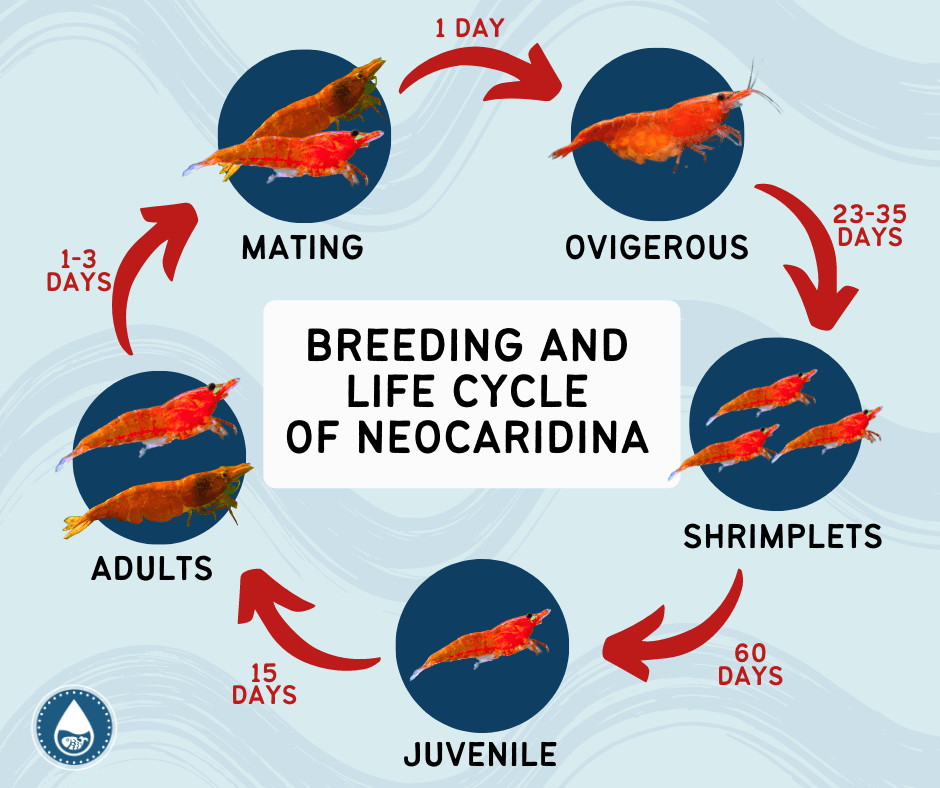
Availability
Low-grade Cherry shrimp are available in most aquarium stores. The shrimp are usually sold in groups of 10 or 20 for discounted rates.
Higher-grade shrimp can be bought online for a slightly higher price.
Shrimp Tank Shopping List
Here’s what you’ll need to buy to set up your Cherry shrimp tank:
- Sponge filter
- Aquarium (5 to 25 gallons)
- Heater (if necessary)
- Aquarium siphon vacuum cleaner
- LED lighting unit
- Live plants
- Tank decorations
- Shrimp pellets and frozen foods
- Gravel substrate
- Water dechlorinator
It’s also helpful to invest in a book on caring for shrimp if you’re new to keeping these cute inverts.
FAQs
Here are some of the most frequently asked questions about keeping and raising Cherry shrimp.

Q: How many cherry shrimp should be kept together?
A: Cherry shrimp do best when kept in groups of at least three. However, the more shrimp you have, the better they’ll like it and the more peaceful the colony will be.
Q: Do Cherry shrimp clean the tank?
A: Cherry shrimp can form part of a tank cleaning crew, eating detritus, leftover fish food, and keeping algae on tank surfaces under control.
Q: Do shrimp need real plants?
A: Shrimp love real aquatic plants! The little invertebrates use the plants for shelter and to travel around the aquarium. Plants tend to harbor algae colonies and collect bits of food, which the shrimp love to graze on.
Q: Do Cherry shrimp need gravel?
A: Although you can use a bare-bottomed tank for shrimp, we strongly recommend using a clean substrate for your shrimp.
Gravel provides somewhere for the growth of biofilm and beneficial bacteria, makes the tank aesthetically more pleasing, and gives you more choices of aquatic plants. In addition, active substrates can help to stabilize your water parameters.
Final Thoughts
Did you enjoy our guide to keeping Cherry shrimp? If you did, please be sure to share it!
Cherry shrimp are beginner-friendly invertebrates that can do well in a small tank with a few small, peaceful tank mates that don’t view the shrimp as a food source. However, if you decide to invest in higher-grade shrimp, we recommend keeping them in a single-species setup.
You can breed Cherry shrimp in your home aquarium relatively easily, so you can maintain a stable population of these charming critters without having to buy more. Why not try cross-breeding differently colored shrimp to prevent reversion to their dull green wild coloration?
What color Cherry shrimp do you keep in your tank? Tell us in the comments box below!
